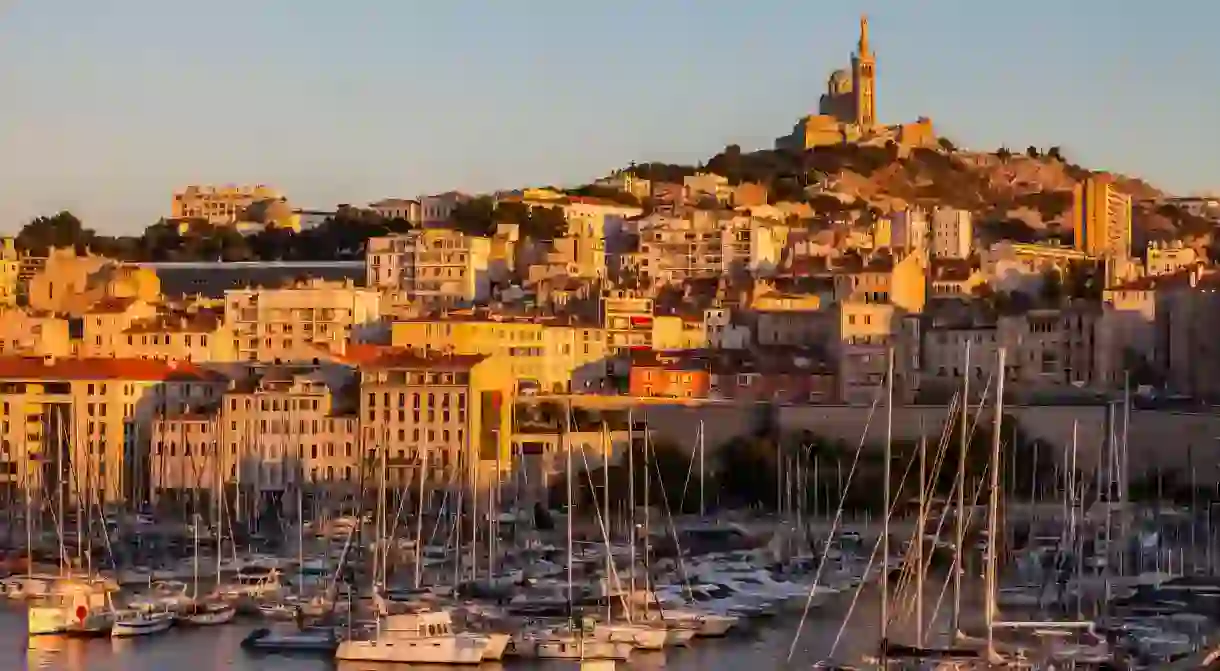Marseille's Most Beautiful Buildings

France’s second largest city is filled with stunning architecture. Magnificent churches and cathedrals, a water palace and Le Corbusier’s brutalist “city within a city” all vie for visitors’ attention. Culture Trip details the most striking buildings the seaside city has to offer.
Basilique Notre-Dame de la Garde
Any guide to Marseille’s most beautiful buildings has to begin with the most famous. The Basilica Notre-Dame de la Garde occupies the highest point in Marseille and overlooks everything. It was completed in 1864 in a Roman-Byzantine style – think domes, mosaic and multicoloured stones. It’s a good starting point for any new visitor; carve out some time to take in the panoramic views or wander through this unique building. Pro tip: take the tourist train from Le Vieux Port for an easier climb up the hill.
Unité d’Habitation

At the end of World War II, Marseille lacked affordable housing and infrastructure. Enter Le Corbusier, the inimitable French architect, who was commissioned to create a residential housing project for the families displaced after the city was bombed. Le Corbusier had a vision of a “city within a city” and spent months designing the perfect affordable housing unit that included flats, shops, schools, a doctor’s surgery and a restaurant. Unité d’Habitation became an influence on brutalism and ushered in a new way of looking at residential design, and today the apartments in the “vertical garden city” are highly sought after. It’s technically a private complex, but you can go up to the roof for the sea view at any time, and tours are also on offer.
Muséum d’histoire naturelle de Marseille

In the 19th century, Marseille’s city council became obsessed with water. More specifically, how to bring it to Marseille from the Durance River, particularly because of the cholera epidemic that was sweeping the city. In 1839, the city began to build the 85km (53mi) canal, which took 10 years and involved the construction of 18 aqueduct bridges. The 19th-century palace that sits here is the crowning glory – a huge edifice to celebrate the water that finally arrived after all the hard work. It now houses the Natural History Museum, as well as the Museum of Fine Arts.
MuCEM

MuCEM, a museum dedicated to the Mediterranean, is right by the ocean, as you’d expect. It consists of two coastal buildings (and a third in the city centre): the historical monument of Fort Saint-Jean and the new J4 building by Rudy Ricciotti and Roland Carta. The gorgeous, filigree-clad J4 is a perfect square (72m/236ft per side), which nods to the classic Latin layout. The museum itself is in another square inside the detailed latticework, and two interlacing walkways connect the J4 with the Fort Saint-Jean. Together, the two buildings create a striking vision of Marseille, past and present.
Cathédrale La Major

Just opposite the MuCEM building and the old Fort Saint-Jean, you’ll find the Cathédrale La Major. The building is actually two cathedrals, one built in the 12th century and another built on the same site in the 19th century. The new one is byzantine in style with multicoloured brickwork, domes and turrets. It is staggeringly big and classified as a national monument. There are also lots of great restaurants on the promenade beneath.
Château d’If

Château d’If is an old island fortress just off the coast of Marseille. After it became redundant as a military outpost, it was turned into a prison because the strong currents acted as a deterrent for potential escapees. It’s small, but well worth a visit for its cultural significance alone. It was here that Alexandre Dumas wrongly imprisoned his hero in his bestseller The Count of Monte Cristo, and the imposing château is still an awe-inspiring building.
FRAC
Japanese architect Kengo Kuma, a disciple of Le Corbusier, is the mastermind behind Marseille’s Centre for Regional Art, FRAC, which is located on the waterfront. The unusual building has a triangular shape, and an enamel glass-covered façade where all panels are mounted at a slightly different angle. It gives the cultural building a curiously animated look, as if it’s in constant motion, and was a reference to how Le Corbusier tried to solve the problem of light by deflecting sunlight. Make sure to check out the stunning gallery space when you’re in Marseille.
L’Église des Réformés
L’Église des Réformés, officially named St Vincent de Paul, sits on the top of the Canebière, the main thoroughfare that leads uphill from the Old Port. It’s at a busy location, a major tram and road intersection, but it would be a shame to miss this church. Built in Gothic style during the 13th century and consecrated in 1888, it’s a spectacular place of worship, with spires reaching 70m (230ft) in height. Go to admire the bronze panels on the massive wooden doors and the expansive 1,270 sq m (14,000sq ft) of stained glass windows, created by Édouard Didron.
Villa Méditerranée
The Villa Méditerranée is another seafront marvel, alongside the MuCEM. Boeri Studio’s cantilevered creation was designed to mark Marseille’s nomination as European Capital of Culture in 2013. It’s a trompe-l’oeil – from the water it seems to be standing on the mainland, but seen from the mainland, it appears to rise up from an island. In reality, it rises from a square of water in the quay, symbolising the bond with the sea. The beautiful concrete and steel building hosts an archive and research centre for projects related to the Mediterranean.
Additional reporting by Cajsa Carlson
Did you know – Culture Trip now does bookable, small-group trips? Pick from authentic, immersive Epic Trips, compact and action-packed Mini Trips and sparkling, expansive Sailing Trips.













